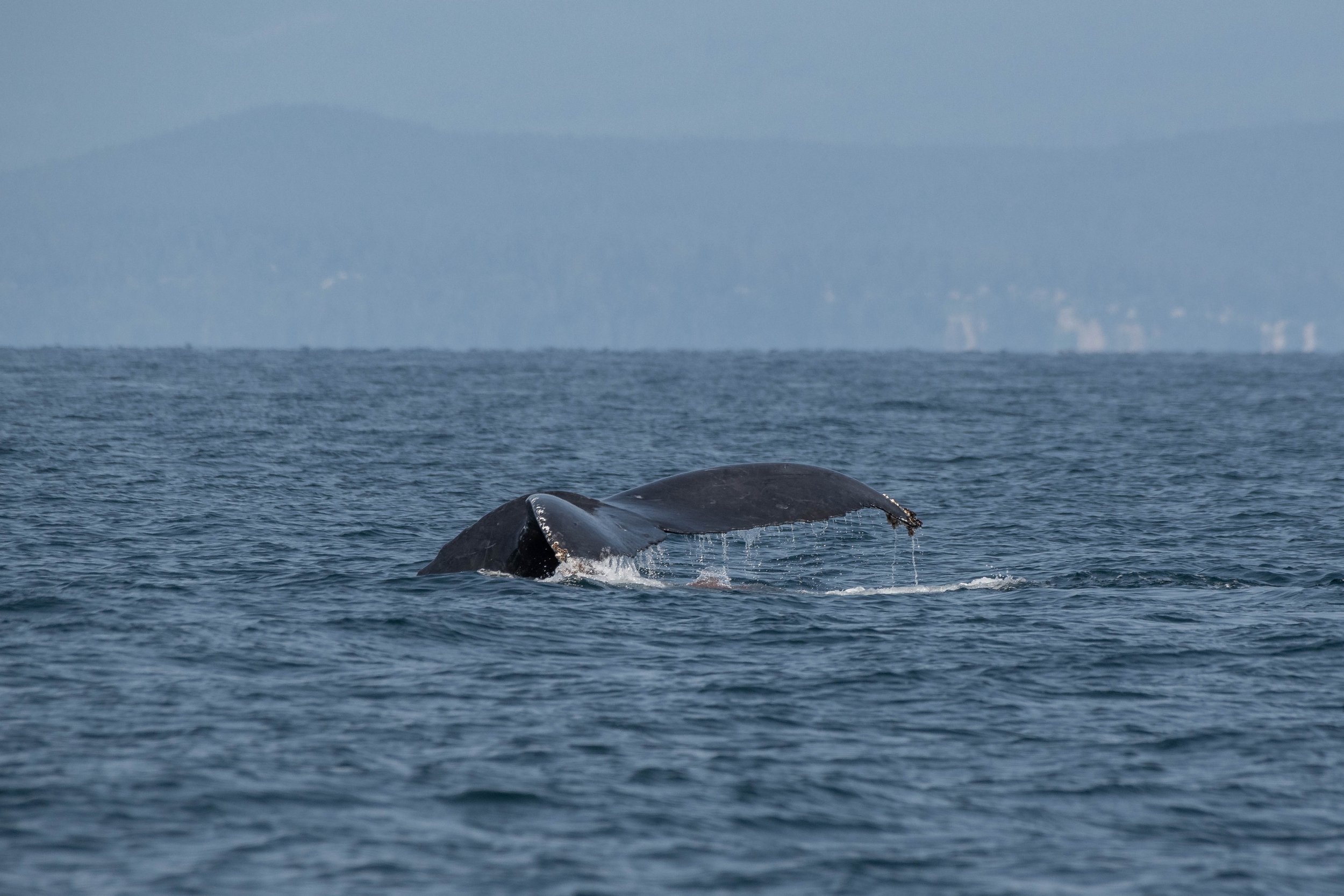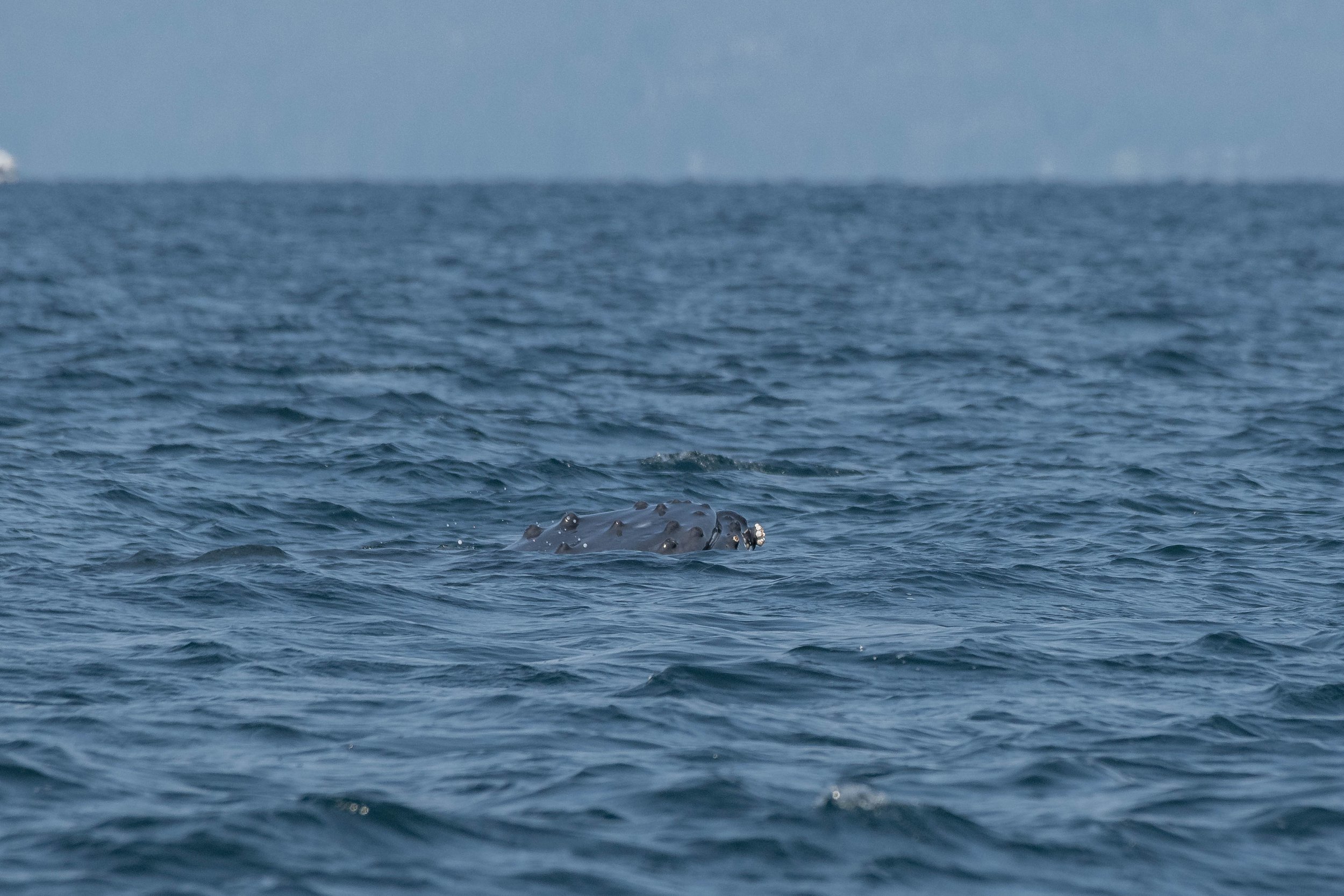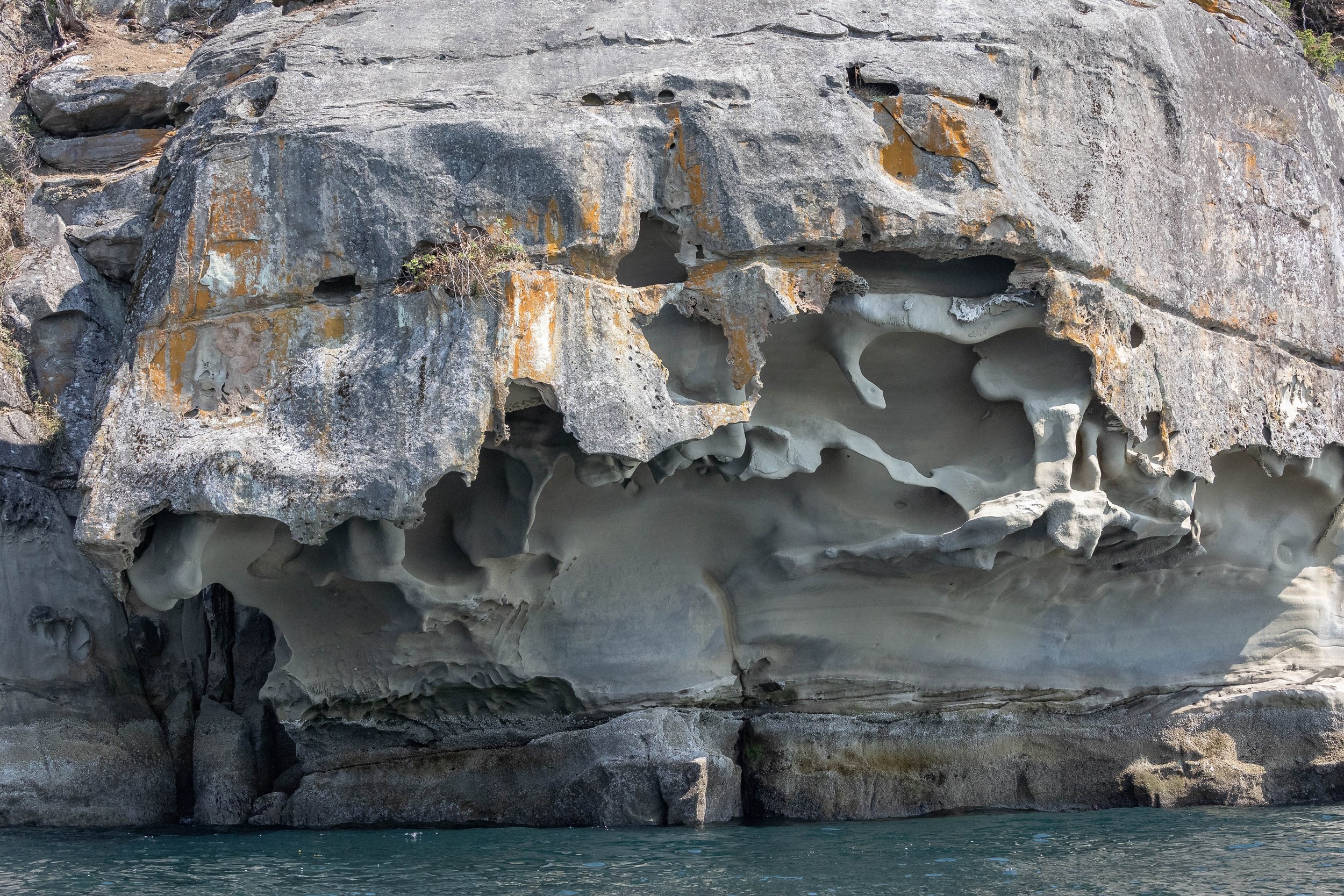August 10, 2024, 10:30 AM - New Humpback Alert!
All three of our boats pushed off the dock this morning, leaving the harbour to head north in search of whales. Thanks to a report from someone watching from land, we had a good idea of where to begin. It didn’t take long for us to locate a pair of Humpback Whales exactly where we’d expected them to be!
These two whales were circling in one spot which likely means they’d found a good area to eat and they were spending their time underwater filling their bellies. Before each dive below the surface, they lifted their tails nice and high, giving us a good look at the unique markings on the underside of their tails which made it easy to identify them as Geometry (BCZ0338) and Stingray (BCZ0409). Geometry is a whale we’re very familiar with as a company as we see them in our area year after year. Stingray, on the other hand, usually frequents the waters further north of our range, so it was especially nice to spend some time with her today. Humpbacks are migratory animals, meaning they move from one region to another according to the seasons. They usually start arriving in our waters around April of each year to spend their summer eating here, as the Salish Sea is their feeding grounds. They stay until around October, when they’ll head down south back to their breeding grounds in either Hawaii, Mexico or Central America for the winter. We typically see the humpbacks show site fidelity; their mom will migrate with them during their first year of life then each year after, they’ll travel between the same two feeding and breeding grounds she introduced them to. Recently, we’ve realised the patterns in which they travel is more complex than we initially thought and not quite so black-and-white. For example, Stripe is a humpback who spends his summers feeding here but has been seen in two breeding grounds, both Hawaii and Mexico. Sherwina spends her breeding season in Hawaii but has been spotted in two feeding grounds, both BC and California. All that to say, although the change in Stingray’s movements aren’t quite as dramatic as the examples, it’ll be interesting to see if we get to spend more time with her in the future.
We left our pair to their meal and headed south to continue our search. Soon enough, we spotted blows on the horizon. We headed in that direction and discovered it was another pair of humpbacks, Crater/Mensa (BCX1565) and Smiley (BCY0995). A lot of the time, our humpbacks will get their name based on their distinguishing features and these two whales are a good example of that. More often than not, the names relate to the way their tail flukes look, which is the case with Smiley. Smiley’s tail has two circular scars above a dark curve, so the markings look like a smiley face (or in our opinion, a creepy clown smiling). Crater, however, got their name based on the way their dorsal fin looks. You can see in the pictures below how most of the whales have ‘normal’ looking dorsal fins whereas Crater’s has a very distinctive shape that makes it look, well… like a crater. These two whales appeared to be resting as we travelled alongside them. This meant we didn’t get to see their tails, as they weren’t lifting them in order to propel themselves down for deep dives, but we did get more time with them up at the surface. We always stay with sleepy whales as they only tend to rest for short periods and occasionally, we’ll see a burst of energy when they wake up. That was exactly what happened today as one of our whales cartwheeled out of the water as they woke! After this excitement, we got a good look at the pair’s tails as they resumed normal behaviour.
After our time with the humpbacks, we set out to explore more of the wildlife the area has to offer. We stopped at an area we’ve ingeniously nicknamed “Seal Rock”, due to it being a popular spot for the Harbour Seals to haul out. Harbour Seals are always adorable but today this was amplified by the presence of seal pups! Pups will only spend the first 3 to 6 weeks of their life with their mom so it’s always special when we get to see them together. We then passed by the Gabriola Bluffs. These impressive sandstone cliffs are a hub of activity for the many species of birds that call them home. The most abundant species are the Pelagic and Double-Crested Cormorants that nest here and the white colouring decorating the side of the bluffs is their guano(/poop)! They actually use this as a cement to help keep their nests secure.
Soon we left the bluffs and birds and crossed back to the Nanaimo Harbour. It was an amazing morning spent with our humpback whales and other wildlife. The onboard naturalists Aly Kohlman, Lucy Willis, and Vanessa Vereschahen captured some beautiful photos from the trip, which can all be viewed below!
The top of Stingray’s tail as she goes for a dive. Photo by Aly Kohlman.
Geometry creating a waterfall as he dives. Photo by Aly Kohlman.
The underside of Geometry’s tail. Photo by Aly Kohlman.
Stingray’s very distinct dorsal fin. Photo by Aly Kohlman.
Geometry lifting their tail to dive. Photo by Lucy Willis.
Stingray’s dorsal fin is covered with barnacles. Photo by Lucy Willis.
Geometry’s dorsal fin with Stingray beside him. Photo by Vanessa Vereschahen.
A wonderful fluke waterfall from the beautiful Stingray. Photo by Vanessa Vereschahen.
Stingray preparing to dive. Photo by Vanessa Vereschahen.
Stingray going for a dive. Photo by Vanessa Vereschahen.
Geometry going for a dive. Photo by Vanessa Vereschahen.
Stingray (left) and Geometry (right) surfacing together. Photo by Vanessa Vereschahen.
Stingray going for a dive. Photo by Vanessa Vereschahen.
Stingray lifting her tail with Geometry’s nostrils just behind her. Photo by Vanessa Vereschahen.
The striking white underside of Stingray’s flukes. Photo by Vanessa Vereschahen.
Stingray diving with Geometry beside her. Photo by Vanessa Vereschahen.
Crater pooping as he dives. Photo by Aly Kohlman.
Either Smiley or Crater’s rostrum sticking out of the water. Photo by Aly Kohlman.
Crater’s dorsal fin blocking Smiley’s tail. Photo by Aly Kohlman.
The beautiful underside of Smiley’s tail flukes, Photo by Aly Kohlman.
The very dark underside of Crater’s tail. Photo by Lucy Willis.
Smiley’s dorsal fin. Photo by Vanessa Vereschahen.
Smiley making a mini fluke waterfall as she dives. Photo by Vanessa Vereschahen.
The underside of Crater’s tail. Photo by Vanessa Vereschahen.
Crater exhaling with smiley’s dorsal fin beside him. Photo by Vanessa Vereschahen.
Smiley’s underside of her tail. Photo by Vanessa Vereschahen.
Smiley giving a little fluke wave. Photo by Vanessa Vereschahen.
The underside of Crater’s tail. Photo by Vanessa Vereschahen.
A Black Oyster Catcher on the Harbour Seal Haul out. Photo by Aly Kohlman.
A mom and pup Harbour Seal. Photo by Aly Kohlman.
Some very cute Harbour Seals with Entrance Island as the backdrop. Photo by Aly Kohlman.
These two Harbour Seals are communicating through touch! Photo by Lucy Willis.
A Bald Eagle watched over us from this treetop. Photo by Aly Kohlman.
A mix of young and adult Cormorants. Photo by Aly Kohlman.
A haggard looking gull chick in the process of loosing it’s down feathers. Photo by Aly Kohlman.
A trio of gull chicks. Photo by Lucy Willis.
The erosion at the Gabriola Bluffs. Photo by Vanessa Vereschahen.





































